
The Durack Clan’s Tempests and Tragedies
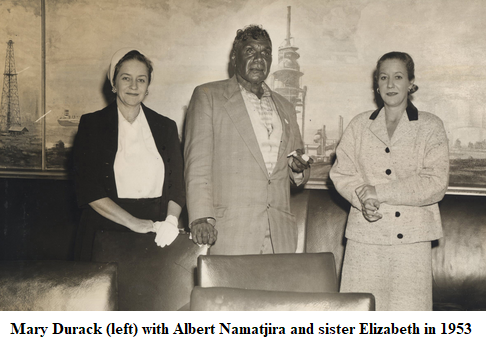
Patsy Millett, daughter of famed Perth writer-historian Mary Durack (1913-94), hasn’t spared the vitriol throughout Inseparable Elements, her astounding memoir of her mother’s tribulations. Least of all does she spare her father, aviation pioneer Horatio ‘Horrie’ Miller, and aunt Elizabeth, the celebrated artist of tribal Aboriginaes.
Dame Mary Durack AC DBE, soft of heart, was beset by rascals, human leeches and time-wasters throughout her long creative life of novels, plays, poems, biographies and kids’ books. She was also suckered into hopeless 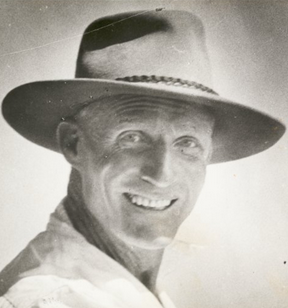 roles in hopeless arts bureaucratic ventures. It’s a miracle she ever completed her immaculately researched bio-epics of her cattle-pioneering forebears, Kings in Grass Castles (1959) and Sons in the Saddle (1983).
roles in hopeless arts bureaucratic ventures. It’s a miracle she ever completed her immaculately researched bio-epics of her cattle-pioneering forebears, Kings in Grass Castles (1959) and Sons in the Saddle (1983).
The Greeks’ Furies would be more tolerant than Patsy in outing Mary’s torments and tormenters. Patsy tosses enough grenades for a 100-year war among Perth’s society. For starters: Mary’s absurd 42-year-long and thankless marriage to brutish Horrie Miller (1893 – 1980). Horrie (right) helped get Qantas started and criss-crossed WA’s North-West in the vintage planes of MacRobertson Miller Airways. As Mary ruminated, “There may have been more selfish men than Horrie, but I never met one.” Today Perth Airport’s main artery is called Horrie Miller Drive. So why did Mary marry him? Patsy writes
When pressed by the curious as to what – frankly – she had been thinking, she would resort to speaking in nebulous terms of her children and the felicitous link with an airline that allowed her travel north free of charge…
Clinging to his solitary and abandoned self-image, Horrie bypassed his extraordinary good fortune in having such a wife, such a family, such freedom and means of movement and adventure … Always insisting that he was working his fingers to the bone in the interests of his family, who were insufficiently grateful, he meanwhile steadily drained family company assets.
Horrie’s operating style wouldn’t cut it these days – he was finally ordered to keep better radio protocol in his Wackett on take-off than, ‘Going for a bit of a spin, shouldn’t be too long.’ As for Patsy, she felt serious urges to patricide when Horrie in her palliative care continued to harass the deteriorating Mary beyond endurance.
Was there not some way to hasten the process of Horrie’s departure? To this end, I conferred with the venerable whodunnit aficionado Ida Mann [a retired outback ophtalmologist], who, all too eager to assist, scrabbled round for the least out-of-date barbiturates from her medical sample drawer. There was no doubt in her mind that such a move constituted a mercy killing. Whether I could have steeled myself to the grim task or whether the intervention of fate saved Horrie from patricide remains undetermined … To the end of my days, I will wake from a nightmare where he is still alive and kicking
Patsy’s tone throughout is wittily sardonic, bordering on incredulous that Mary could absorb so many arrows and impositions mixed with friendly fire from family and in-law elements. Patsy gives Mary’s artist sister 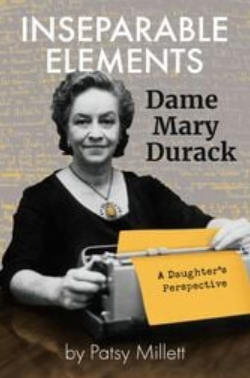 Elizabeth – a lifetime cadger from Mary – a particularly bad press
Elizabeth – a lifetime cadger from Mary – a particularly bad press
Bet could, over the decades, be found supporting some fairly obnoxious political figures, although Joh Bjelke-Petersen was not in the same ballpark as Hitler, for whom during the war years she had formed an ardent admiration . Perforce always chasing the money and power, had her stars been otherwise aligned she might easily have slipped into a role such as that occupied by Leni Riefenstahl.[1]
Elizabeth herself could be merciless, prone to
…demolish anyone who crossed her path, including, without compunction, those held dear by her sister. Absorbed by her artist’s eye, she disposed of [novelist] Ernestine Hill as ‘ a little scorched-up leaf ’, and [historian] Henrietta Drake-Brockman as ‘ Nicely dressed, clear, fair skin, well done hair, hands that have done no hard work – a numbskull, not even likable like the average nitwit ’. [2]
While all families have their feuds, Elizabeth was capable of furthering them, even to the Supreme Court, in her irrational fight over control of Mary’s Durack archive. Mary during this unsought fracas was on her deathbed with stomach cancer.
Bet was the driver of this runaway bus and her destination more far-flung than the others were able to grasp. Duplicity her stock in trade, she was a virtuoso when it came to pitting one family member against another and switching sides at will.
After loosing this intra-family wrecking ball and with Mary dead, Elizabeth was surprised not to be forgiven, according to Patsy, who signs her off:
Fatally freed from Mary’s restraining hand, she was soon heading for the next – and ultimate – reckless stunt . Eddie Burrup was just over the horizon .
By this Patsy refers to Elizabeth’s selling work in the persona of an imaginary Aborigine, ‘Eddie Burrup’. However, Patsy is never small-minded and sums up:
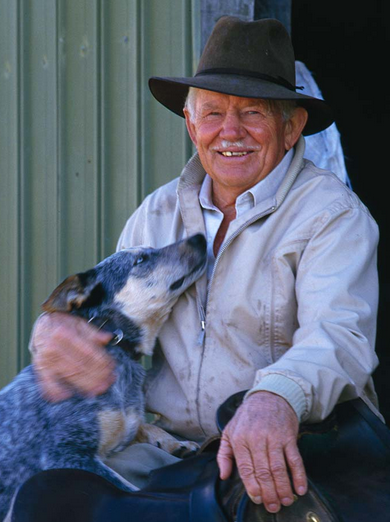 Changing faces and motivations according to requirements, even her pictures subject to caveat emptor, she was a genuine miracle of contrivance – one who would nonetheless produce images powerful enough to eclipse anything that might be revealed by her puny detractors, including this niece.
Changing faces and motivations according to requirements, even her pictures subject to caveat emptor, she was a genuine miracle of contrivance – one who would nonetheless produce images powerful enough to eclipse anything that might be revealed by her puny detractors, including this niece.
Among Mary’s exploiters was boot-salesman R.M. Williams (right), who inveigled her onto the board of the Stockman’s Hall of Fame at Longreach with blah-blah about including the north-west cattle industry. He only wanted her name as a PR drawcard. At the 1988 official opening, they seated her with Queen Elizabeth:
Next to the costly ensembles and silly hats, she looked singularly unpretentious, if a little surprised, since prior warning of the prestigious seating had somehow escaped her. The loose perm given way to a neat French roll, she presented a respectable but homespun figure.
As a nod to the madness of the Whitlam times, someone nominated Mary as a potential State governor and there was even press talk of her as our first female Governor-General, in a hypothetical contest with the louche Germaine Greer.
Mary had four daughters and one son by Horrie, and I was startled to learn from Inseparable Elements that in 1955, Mary, at the age of 42, had a last child, Johnson, by her live-in odd-job man Bob Hill during Horrie’s north-west flying absences.
Entering her room one morning, I had seen the house guest going out the window, and my mind shied away from what seemed my mother’s descent into some kind of French farce. And so, knowing as I did, I simply dismissed the possibility. In retrospect, what happened is plain enough … She had always regarded Bob as a permanent adolescent who, for all his fooling about with paint and poetry, was no more than a likable ratbag. Predicaments of this sort not unfamiliar to her, it would have been utterly confounding that dear, sensible ‘Mare’ had fallen to such a folly, the worse for it not being in her sister’s nature to avail herself of the practical means of extrication .

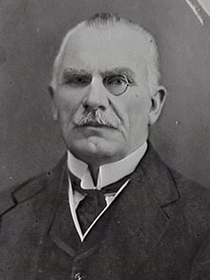 Further particulars are baroque. Horrie, cuckolded, put up with the cuckoo.
Further particulars are baroque. Horrie, cuckolded, put up with the cuckoo.
Bob Hill himself was the son of Ernestine Hemmings, later “Hill”, celebrated author of the Matthew Flinders novel My Love Must Wait. Patsy confirms Bob Hill was sired by Kerry Packer’s grandfather Robert Clyde Packer (right), in what was poor Ernestine’s probable “one and only dalliance.” Ernestine made what Patsy calls “an expedient retreat” to Tasmania and there invented a husband called Mr Hill. R.C. Packer provided some cash support and Bob’s school fees to age 11, when Packer died.
A Perth contemporary of Patsy, I’d imagined the Duracks’ family home “Mildew” in Nedlands[3] as an oasis of creativity. More the opposite, with Horrie adding his chainsaw to one episode of backyard bedlam.
…enhanced by a multilayered sound track combining Johnson’s guitar, Sesame Street at top volume from the TV, a barking puppy running dangerously underfoot, and [secretary] Connie’s sharp tones directed at the resident mother for her lack of control over her child .
Anything but a businesswoman, Mary entered gross commitments of time and creativity “with as little concern as she signs a grocery bill”. Case in point: script-writing for a Swan River Saga theatrical, grossing $10,381 and for which she was paid $259. She labored gratis over months to edit the legends of an Aborigine called Butcher Joe, and was taken aback, Patsy says, to learn that writer Hugh Edwards[4] required a $5000 grant to complete the job.
Mary suffered her cruellest blows from the deaths of two daughters, Julie, at just 27, and outback nurse-pilot Robin at 35. Julie was felled during pregnancy from complications stemming from a botched operation by an incompetent medico when a child. Robin (below), in the midst of her daily work flying trauma cases to hospital, was struck down by melanoma.

Julie in Broome in 1949 got a bad stomach ache. The available locum, somewhat the worse for wear and, according to Patsy, biased by an extra-marital affair he was having with Elizabeth, assumed an appendix problem. Julie’s pain was actually just from eating unripe mangoes. Describing the “shocker” of an operation, Patsy says,
Unable to find the appendix but convinced of his diagnosis, the doctor kept cutting until, located at last, a normal and uninflamed appendix was removed . A long time recovering, Julie was left with a livid scar from the right side of her abdomen to the navel . But by 1952, the event was no more than a bad memory and Julie restored to good health and cheer. Not even Horrie, acquainted as he was with the concept of connective elements, foresaw the forging of the first awful link in a tragic chain.
Twenty years later, in an under-equipped small hospital, she died of complications from another faulty operation to fix the original damage. Sister Robin authored two best-sellers about her flying nurse role.[5] In Patsy’s words,
Through her hands passed a gruesome parade of burns, bashings, botched suicides and incomplete abortions; victims massively haemorrhaging within the confines of a small aircraft all over her and other patients aboard. And always for her the most heart-rending sight : the limp little hands of dead or dying children. Unmasked and vulnerable, she sat cheek by jowl with infectious diseases : tuberculosis, hepatitis, glandular fever … It was the pilot’s responsibility to restore the cabin to a sanitary state, and that for Robin included taking linen and seat covers home for washing and mending.
By 1975 she herself was gravely ill. Her rigors were worsened by an incorrect pathology report leading to an overdose of radium therapy. Her torments included her despicable and parasitic husband, Dr Harold Dicks, (according to Patsy), a Royal Flying Doctor Service stalwart and president. In her last days, Robin woke to see Harold forcing a “vulgar embrace” on her sister Anne-Marie. “Stop it, Harold,” Robin said. “I know what you are doing.” Within days of Robin’s death, Harold was also coming on to an outraged Patsy as well; within three weeks he found a new girlfriend and in six weeks installed a woman among Robin’s belongings at suburbia’s inaptly named Mt Pleasant. Patsy later discovered Harold surreptitiously visiting Mildew.
Suddenly overcome with revulsion and rage, and having the hose in hand, I flushed him off the property – down the garden path, past the ‘bear-pit’ where with Robin he had so often enjoyed the hospitality of the house, and out the gate. Unfortunately, the weak water pressure made it a symbolic gesture that dampened rather than cannoned him away on the end of a jet. ‘How do you live with yourself, Harold Dicks!’ I shouted rhetorically, to the wonderment of my watching children.
Robin’s headstone had the quotation from aviator Antoine de Saint-Exupery:
“Can these be the same stars? Is this the same sky? How bright, how clear, what safety I have reached.”
Patsy also has much to recount of Mary’s involvement in Aboriginal theatre and politics, including city-based climbers fostering race-hatred and pushing aside tribal members and their “fossilised culture”. We get vignettes such as Mary trying to organise an Aboriginal Theatre Foundation performance in Broome, with women from La Grange Mission “who modestly insisted on dancing in white bras and pink slips”.
A Whitlam grant despatched a 140-strong troupe to a festival of black artists in Lagos, Nigeria, where amid chaos our urban “black power” members trumped their tribal rivals.[6]
In the prevailing melee, the one performance of a genuine corroboree failed, along with the sound and lighting. Eighteen members, disassociating themselves from the messages of discord from their city brothers, pulled out. Unique Australian Aboriginal culture had, in a final mockery, been represented by a sassy urban group dancing Filipino jazz ballet to American soul music. Kath Walker, there to promote black literature, had blamed the whites and the tribal groups for ‘being out of their element’ and producing a ‘flop’. Amid widespread criticism at home, the $203,000 grant that had gone into the project was put down to the folly of the previous government.”
Mary’s years of work for the Aboriginal Theatre Foundation, and the ATF itself has now gone down the memory hole.
That there is today virtually no record of this enterprise to be found in any public institution raises conjecture that it has been ‘disappeared’ as inconvenient to more popular (or less contentious) constructions of Aboriginal contemporary history.
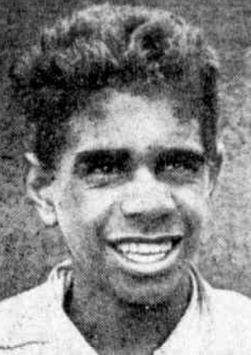 Mary’s attempted sponsorship of the scattered remnant of the original Carrolup Aboriginal artists of the south-west provides another vignette. She located Aboriginal artist Revel Cooper (left) in Fremantle Prison, his life a disquieting “tale of confusion and alienation that could be applied to so many of his countrymen”.
Mary’s attempted sponsorship of the scattered remnant of the original Carrolup Aboriginal artists of the south-west provides another vignette. She located Aboriginal artist Revel Cooper (left) in Fremantle Prison, his life a disquieting “tale of confusion and alienation that could be applied to so many of his countrymen”.
And all too poignantly predictable was the end of the story. On his release, having blown his cheque from the publisher, Cooper began to turn up at [Nedlands family home] Mildew to demand further payment from his patron. With a waiting taxi full of his extended family, if he found no-one home he would bail up neighbours. Sadly knowing that it was just a matter of time, Mary could only see him away with the contents of her purse. Periodically re-incarcerated, he would eventually be killed in a drunken brawl.
Utterly poignant was the official treatment of Aborigines and their culture when, in 1971, the Ord Dam drowned the Duracks’ Argyle holdings.
Bulla, keeper of the ancient stones and tjuringa boards, forfeited his entire cache to the waves . Why, he continued to ask, had ‘the old boss’ left his properties to strangers rather than to the Aboriginal workers he had trained and who belonged there? He was genuinely bewildered by this. ‘We feel we lose everything that we belong,’ he said, and his sorrowful summary of the situation for himself and his people became the title of the coming ABC Big Country episode.
Patsy has little to nothing to report on the alleged “stolen generation” crimes of Mary’s parents’ era, other than forced removals to quarantine hospital of those afflicted with leprosy, and pastoralists’ casual ‘picking up’ of Aboriginal children to raise for station labour.[7]
“I suppose we can’t sit in judgment,” Mary wrote, “no-one in the old days would have suggested blacks had human rights.”
The Durack-Miller clan had something in common with the forlorn Trappist missionaries of the 1890s north-west. Mary wrote:
They expected to find ‘ crosses ’ and to embrace them – even martyrdom, but the greatest crosses they had to bear were not from external discomforts or persecutions but from their own inner conflicts and each other.
Inseparable Elements is a moving and fascinating insight into the heartland of a great Australian family. As Patsy sums up,
Through the pages of my mother’s diaries, I relive our close and sometimes embattled relationship – the furious love and jealous guardianship of her creative flame that yet demands my vigilance.
Tony Thomas’s just-published “Foot Soldier in the Culture Wars” ($29.95) is available from author at [email protected] or publisher Connor Court
[1] Hitler’s chronicler in her propaganda films
[2] The family dubbed the elderly Henrietta Drake-Brockman as “Henrietta Great-Frogman” for her penchant for diving on wrecked Dutch galleons.
[3] A witty and later apt amalgam of the Miller and Durack names
[4] Island of Angry Ghosts about the Abrolhos Batavia wreck and a score of other works
[5] Perth Airport’s Sugarbird Lady Road is named after Robin. She wrote Flying Nurse (1971) and Harold completed Sugarbird Lady (1975) from her archive.
[6] The roll-call was 30 tribals vs 110 urban hangers-on.
[7] Indefensible by today’s standards, this picking-up is in a different category to the “stolen” syndrome. As Patsy notes, “One of the Aboriginal children thus casually acquired was Boxer, who became a CD&D [Durack] stockman and lifelong henchman of M.P.Durack.”
Madam: Archbishop Fisher (July-August 2024) does not resist the attacks on his church by the political, social or scientific atheists and those who insist on not being told what to do.
Aug 29 2024
6 mins
To claim Aborigines have the world's oldest continuous culture is to misunderstand the meaning of culture, which continuously changes over time and location. For a culture not to change over time would be a reproach and certainly not a cause for celebration, for it would indicate that there had been no capacity to adapt. Clearly this has not been the case
Aug 20 2024
23 mins
A friend and longtime supporter of Quadrant, Clive James sent us a poem in 2010, which we published in our December issue. Like the Taronga Park Aquarium he recalls in its 'mocked-up sandstone cave' it's not to be forgotten
Aug 16 2024
2 mins







